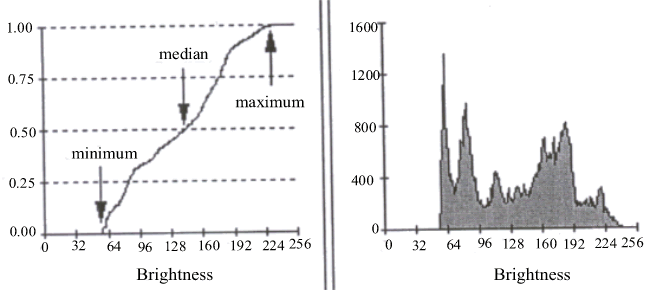Statistics
- Probability distribution function of the brightnesses
- Probability density function of the brightnesses
- Average
- Standard deviation
- Coefficient-of-variation
- SignaltoNoise ratio
In image processing it is quite common to use simple statistical descriptions of images and sub-images. The notion of a statistic is intimately connected to the concept of a probability distribution, generally the distribution of signal amplitudes. For a given region-which could conceivably be an entire image-we can define the probability distribution function of the brightnesses in that region and probability density function of the brightnesses in that region. We will assume in the discussion that follows that we are dealing with a digitized image  . .
Probability distribution function of the bright nesses
The probability distribution function,  , is the probability that a
brightness chosen from the region is less than or equal to a given brightness
value a. As a increases from , is the probability that a
brightness chosen from the region is less than or equal to a given brightness
value a. As a increases from
 increases from 0 to 1. increases from 0 to 1.  is monotonic,
non-decreasing in a and thus is monotonic,
non-decreasing in a and thus  . .
Probability density function of the brightnesses
The probability that a brightness in a region falls between a and  ,given the probability distribution function ,given the probability distribution function  can be expressed as can be expressed as  where where  is the probability density function. is the probability density function.
Because of monotonic , non-decreasing character of  we have we have   and and
   . For an image with quantized (integer) brightness amplitudes, the interpretation of . For an image with quantized (integer) brightness amplitudes, the interpretation of  is the width of a brightness interval. We assume constant width intervals. The brightness probability density function is frequently estimated by counting the number of times that each brightness occurs in the region to generate a histogram, is the width of a brightness interval. We assume constant width intervals. The brightness probability density function is frequently estimated by counting the number of times that each brightness occurs in the region to generate a histogram,  .The histogram can then be normalized so that the total area
under the histogram is 1. Said another way, the .The histogram can then be normalized so that the total area
under the histogram is 1. Said another way, the  for region is the normalized count of the number of pixels, N, in a region that have quantized brightness a: for region is the normalized count of the number of pixels, N, in a region that have quantized brightness a:
The brightness probability distribution function for the image is shown in Figure(1. 6a). The (unnormalized) brightness histogram which is proportional to the estimated brightness probability density function is shown in Figure(1. 6b). The height in this histogram corresponds to the number of pixels with a given brightness. 
Figure (1.6a) |
Figure( 1.6b) |
Figure(1. 6): (a) Brightness distribution function of Figure(1. 4a) with minimum, median, and maximum indicated.
(b) Brightness histogram of Figure (1.4a).
Both the distribution function and the histogram as measured from a region are a statistical description of that region. It must be emphasized that both  and and  should be viewed as estimates of true distributions when they are computed from a specific region. That is, we view an image and a specific region as one realization of the various random processes involved in the formation of that image and that region . In the same context, the statistics defined below must be viewed as estimates of the underlying parameters. should be viewed as estimates of true distributions when they are computed from a specific region. That is, we view an image and a specific region as one realization of the various random processes involved in the formation of that image and that region . In the same context, the statistics defined below must be viewed as estimates of the underlying parameters. |